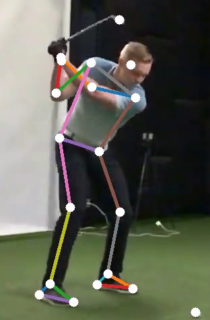ID 2362: AI-driven biomechanical golf swing analysis
Master’s Thesis / Research Internship / Student Assistant
The golf swing is arguably one of the most complex whole-body movements in sports [1]. It requires significant physiological effort and precise neuromuscular control to accelerate the clubhead to more than 160 km/h in one-fifth of a second [2]. This complexity requires dedicated training and coaching feedback in order to improve the swing outcome, which is typically defined by direction precision as well as stroke length. The training and feedback component requires precise biomechanical information regarding the swing execution.
The 3D movement pattern of the golf swing can already be recorded with high accuracy. The current gold standard is 3D kinematography [3], however, single-view video [4] and inertial measurement units [5,6] have also been employed. There is also parallel research at FAU [7] and also internationally [8] regarding the use of radar- and other EM-wave-based sensing for movement analysis. Still, all these methods have not found wide-spread adoption in human or AI-driven coaching practice. Single-view video is partially used for this purpose (e.g. “OnForm: Video Analysis App”, “Swing Profile Golf Analyzer”) because it is the method that can most realistically be integrated into swing practice. However, there is no apparent product or research that uses the most recent developments in marker-free biomechanical motion analysis: for example, pose estimation using part affinity fields [9] or based on user-defined body parts based on deep & transfer learning [10].
The purpose of this thesis is therefore to research whether these recent contributions in AI-driven marker-free biomechanical motion analysis based on single-view (or multiple-view) video are applicable in golf swing analysis. The work plan of this thesis is to
- analyze the current literature, app market, and patents regarding (biomechanical) measurement and analysis of the golf swing
- (optionally) conduct expert interviews regarding existing research and applications
- propose at least 2 possible AI-based biomechanical golf swing analysis approaches based on single-view (or multiple-view) video
- implement one of the proposed approaches
- propose and conduct a technical validation study with at least 10 participants to investigate the accuracy of the implementation.
The results of this thesis will also be used within a second parallel Master thesis (“AI-driven coaching for golf swing improvement”). This thesis will use the biomechanical analysis results to drive an AI-based coaching feedback study. The vision of these theses projects is to contribute to research and development of, in the long run, an AI-driven feedback training system to improve the swing of individual golfers, also including the use of radar- and other EM-wave-based motion measurement principles.
The thesis must contain a detailed description of all developed and used algorithms as well as a profound result evaluation and discussion. The implemented code has to be documented and provided. An extended research on literature, existing patents and related work in the corresponding areas has to be performed.
[1] A. McHardy, H. Pollard. Muscle activity during the golf swing. British Journal of Sports Medicine 39, 799-804, 2005.
[2] M. H. Cole, P. N. Grimshaw. The biomechanics of the modern golf swing: implications for lower back injuries. Sports Med 46, 339–351, 2016.
[3] B. M. Nigg, G. K. Cole, I. C. Wright. “Optical methods”, in: Biomechanics of the musculo-skeletal system, B. M. Nigg and W. Herzog Eds., 3rd ed. New Jersey, NJ, John Wiley & Sons, ch. 3.6, 302-331, 2007.
[4] R. Urtasun, D. J. Fleet, P. Fua. Monocular 3–D Tracking of the Golf Swing. Proceedings of the Computer Vision and Pattern Recognition Conference, 932-938, 2005.
[5] R. Burchfield, S. Venkatesan. A Framework for Golf Training Using Low-Cost Inertial Sensors. In Proc. of the BSN 2010, Singapore, 267–272, 2012.
[6] U. Jensen, P. Kugler, F. Dassler, B. Eskofier. Sensor-based Instant Golf Putt Feedback. In Proc. of the IACSS 2011, Shanghai, 49–53, 2011.
[7] www.empkins.de, accessed 26.6.2021.
[8] F. Adib, C. Hsu, H Mao, D. Katabi, F. Durand. Capturing the Human Figure through a Wall. ACM Transactions on Graphics. 34(6), 1–13, 2015.
[9] Cao, T. Simon, S. Wei, Y. Sheikh. Realtime Multi-Person 2D Pose Estimation Using Part Affinity Fields. Proceedings of the IEEE Conference on Computer Vision and Pattern Recognition (CVPR), 7291-7299, 2017.
[10] Mathis, P. Mamidanna, K. M. Cury, T. Abe, V. N. Murthy, M. Weygandt Mathis, M. Bethge. “DeepLabCut: markerless pose estimation of user-defined body parts with deep learning,” Nat. Neurosci. 21(9), 1281-1289, 2018.




